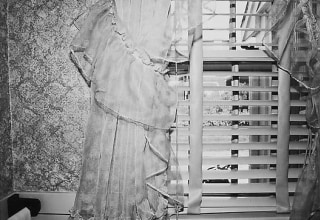
Exhibition Dates: March 2 - April 13, 2013 b>Opening Reception with the artist: March 2, 2013 6 - 8pm
The Joseph Bellows Gallery is pleased to announce the first West Coast exhibition of the photographs of Arnold Kramer. This is also his first solo show in a gallery in 25 years. It will feature a pivotal group of pictures, showcased to critical acclaim in a 1978 exhibition at the Corcoran Gallery of Art in Washington D.C. entitled Interior Views.
These black and white photographs, with their sharp eye for the pattern and details of domestic settings, established Kramer as a distinct talent whose avoidance of “romantic bombast” and “emphasis on formal clarity,” in curator Jane Livingston’s view, made his pictures particularly fresh. In their emphasis on a emotionally restrained, frontal views of rooms they look back to the work of the 20th century American great Walker Evans. In their attention to pattern and line as visual motifs within everyday spaces, he reveals his bond with another 20th century photographic master, his mentor Minor White.
“Arnold has a wonderful way of creating a three dimensional scene within the sheet of photographic paper,” says Joseph Bellows. “In his photographs of rooms, objects and patterns that can appear to look haphazard and random are flattened out and pieced together to create a marvelous kind of collage effect.” “I try to strike a balance between commitment to craft and commitment to seeing,” Kramer once explained.
The impact of this thinking is evident in his seductive series of interiors, which began with pictures made in the Baltimore home of his wife’s parents. The spectrum of interiors expanded to include settings in homes of friends, family and others that spanned Baltimore, Washington and his hometown of Boston/Cambridge. Kramer displayed his keen attention to domestic arrangements in a picture like #13 family room, Randallstown, Maryland, with its concentration on a wonderfully quirky interplay of chairs and plants, offset by rectangles below (on the floor) and above (in picture frames and window frames). Alternately, his sensitivity to the ritualistic trappings of the home is at play in #39 bureau top, Washington DC, with its display of family photographs against the backdrop of the single framed image of Jesus on the wall directly behind them, as if he were presiding over these portraits. A single bulb above the head of Jesus is a deft flourish of visual wit. All of the photographs in this series reveal the same attention to formal detail and social nuance. Yet their everyday sights consistently add up to a cogent and evocative whole.
“These places transcend their own banality to become rather fabulously beautiful,” Kramer aptly asserted. For Kramer, meeting Minor White was pivotal. He enrolled in one of White’s classes while earning a Master’s Degree in Electric Engineering at the Massachusetts Institute of Technology (completed in 1968). On the basis of some pictures he had made for his high school yearbook, White allowed him to enter his advanced class in photography at M.I.T. and ultimately became Kramer’s mentor. He studied with White for five years beginning in 1967 and it was White’s insistence that his students strive for original vision in their work as much as excellent technique that was crucial to Kramer’s development as an artist.
He was the recipient of fellowships from the National Endowment for the Arts in both 1975 and 1979. From 1970 until 1981, Kramer was on the faculty of the School of Architecture at the University of Maryland, teaching undergraduate and graduate courses in still photography. During the 1980s, he also had a flourishing practice as an architectural and commercial photographer in Washington, D.C. He has served on the staff of the United States Holocaust Memorial Museum since 1987, heading up its Information Office and overseeing its technological initiatives for exhibitions and national outreach, as well as creating photographs for its archives and exhibits. Among collections in which Arnold Kramer is represented include: Birmingham Museum of Art, Corcoran Gallery of Art, National Museum of American Art, Addison Gallery of American Art and The Baltimore Museum of Art.